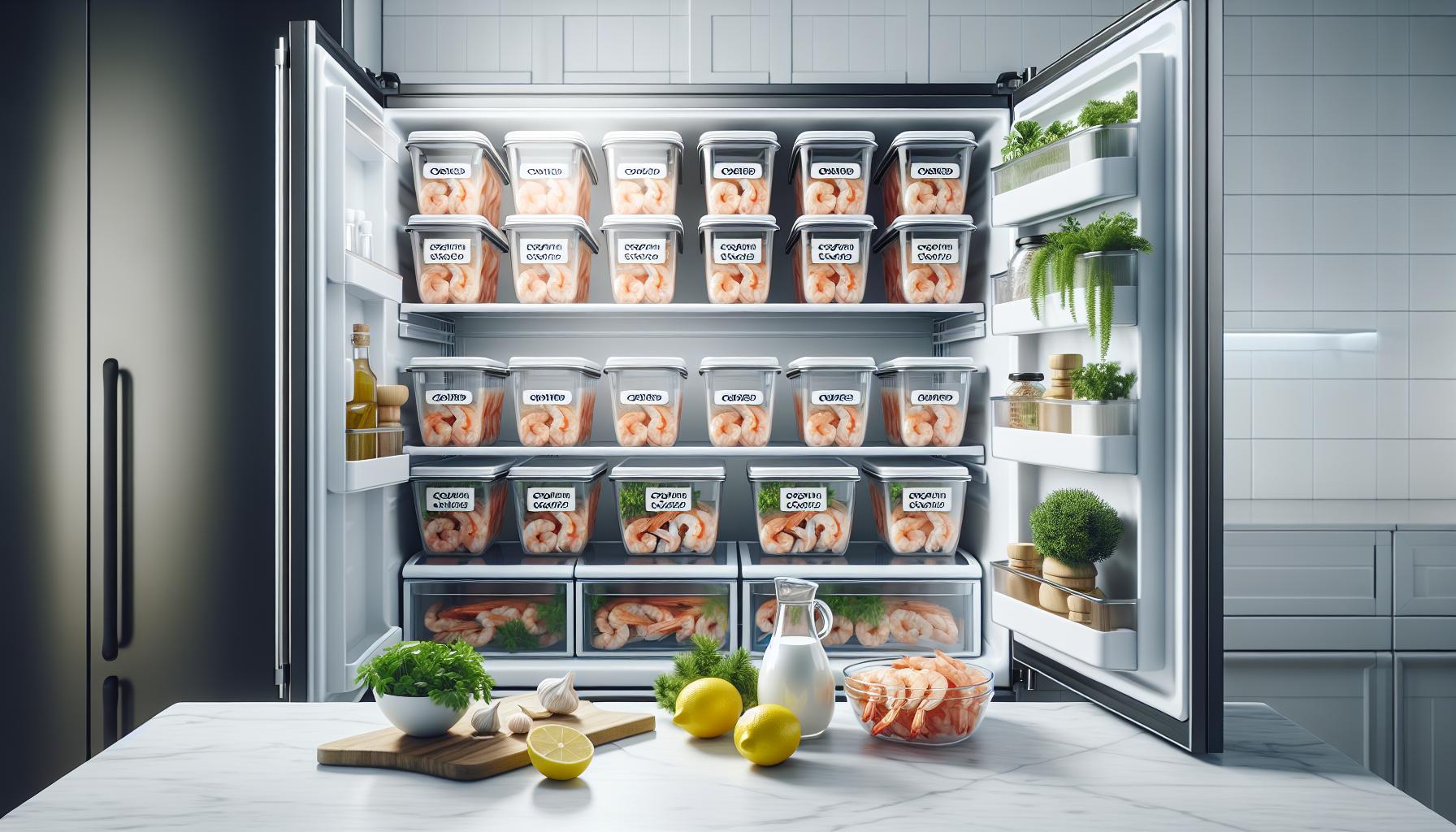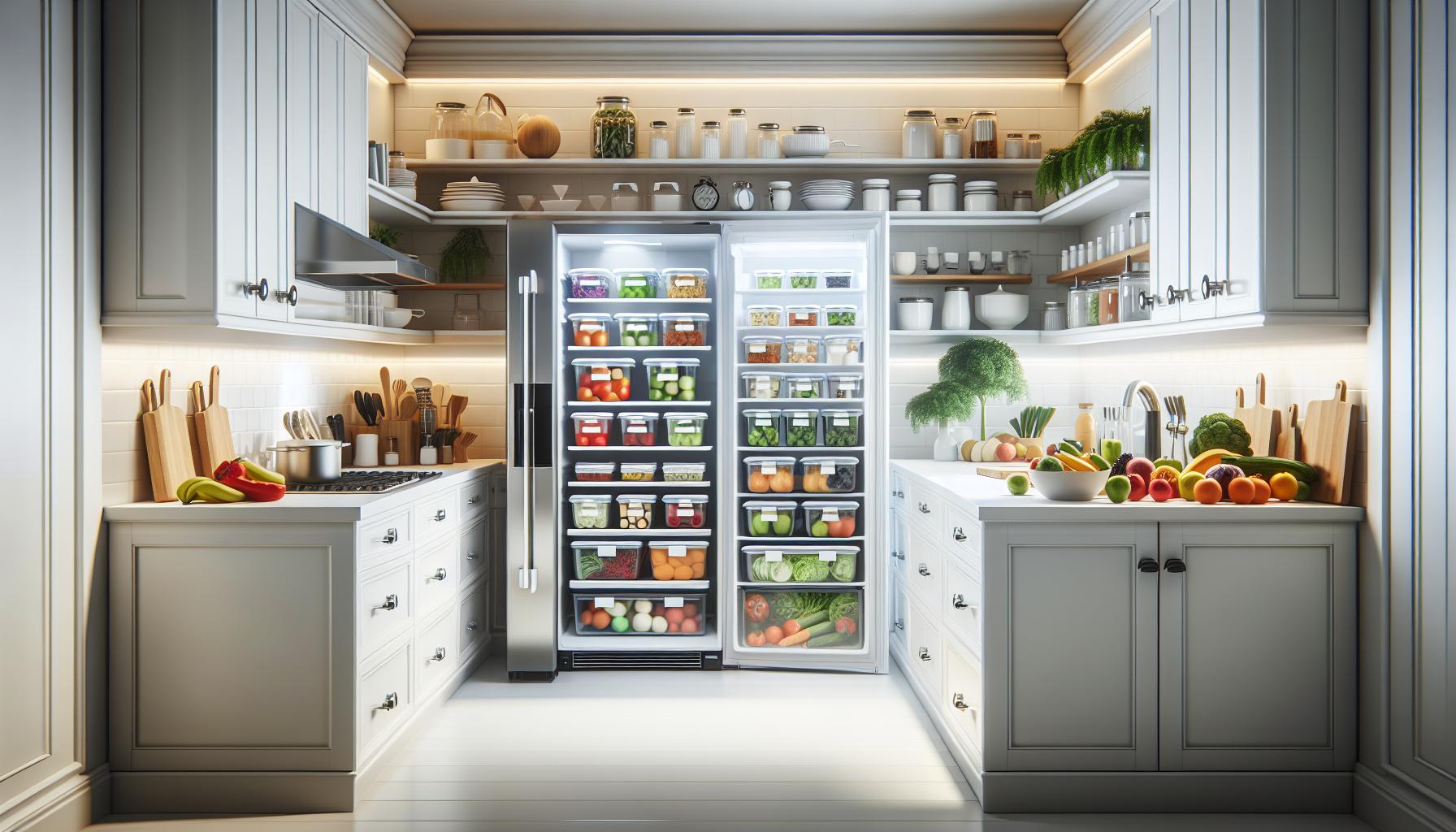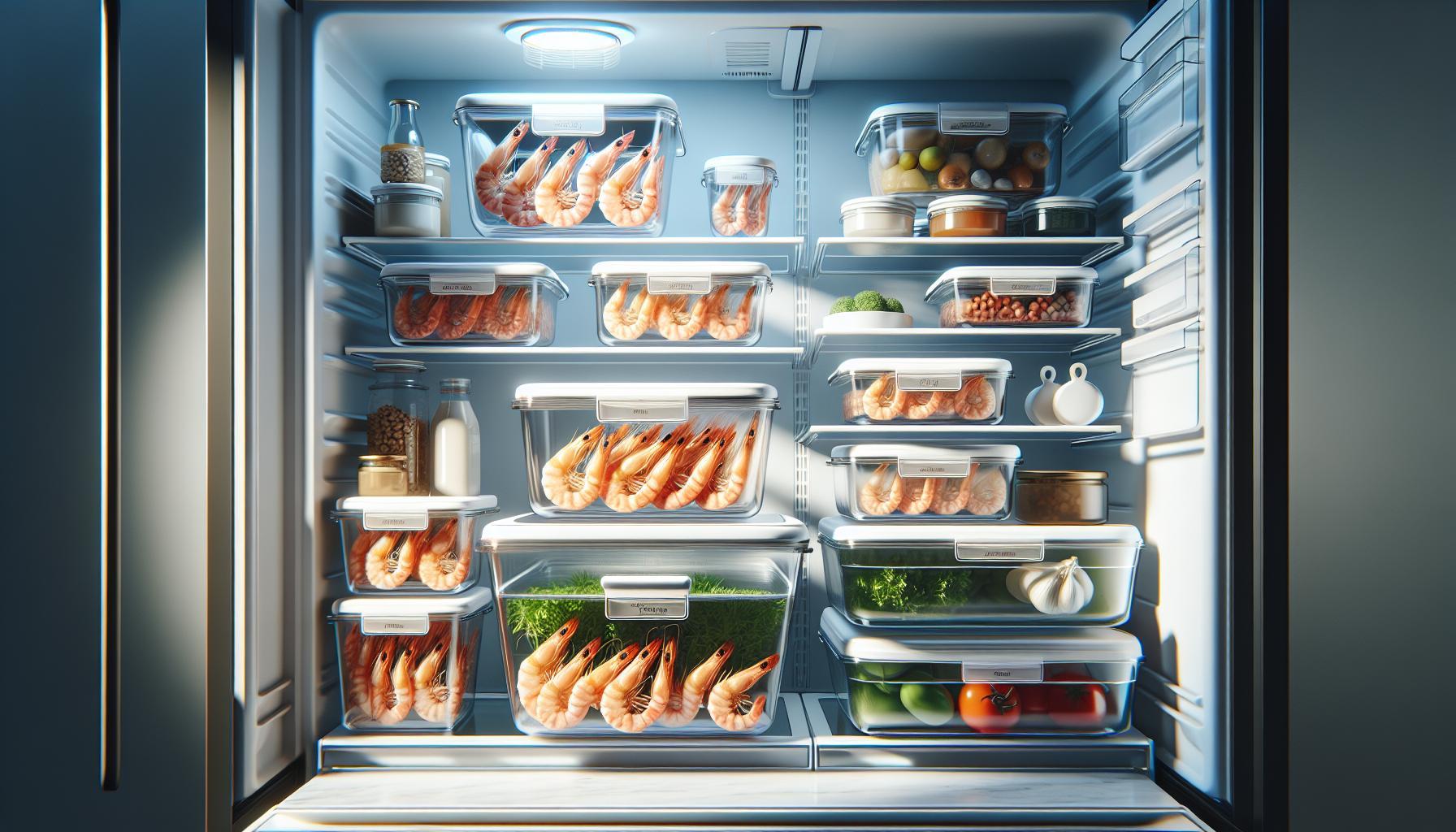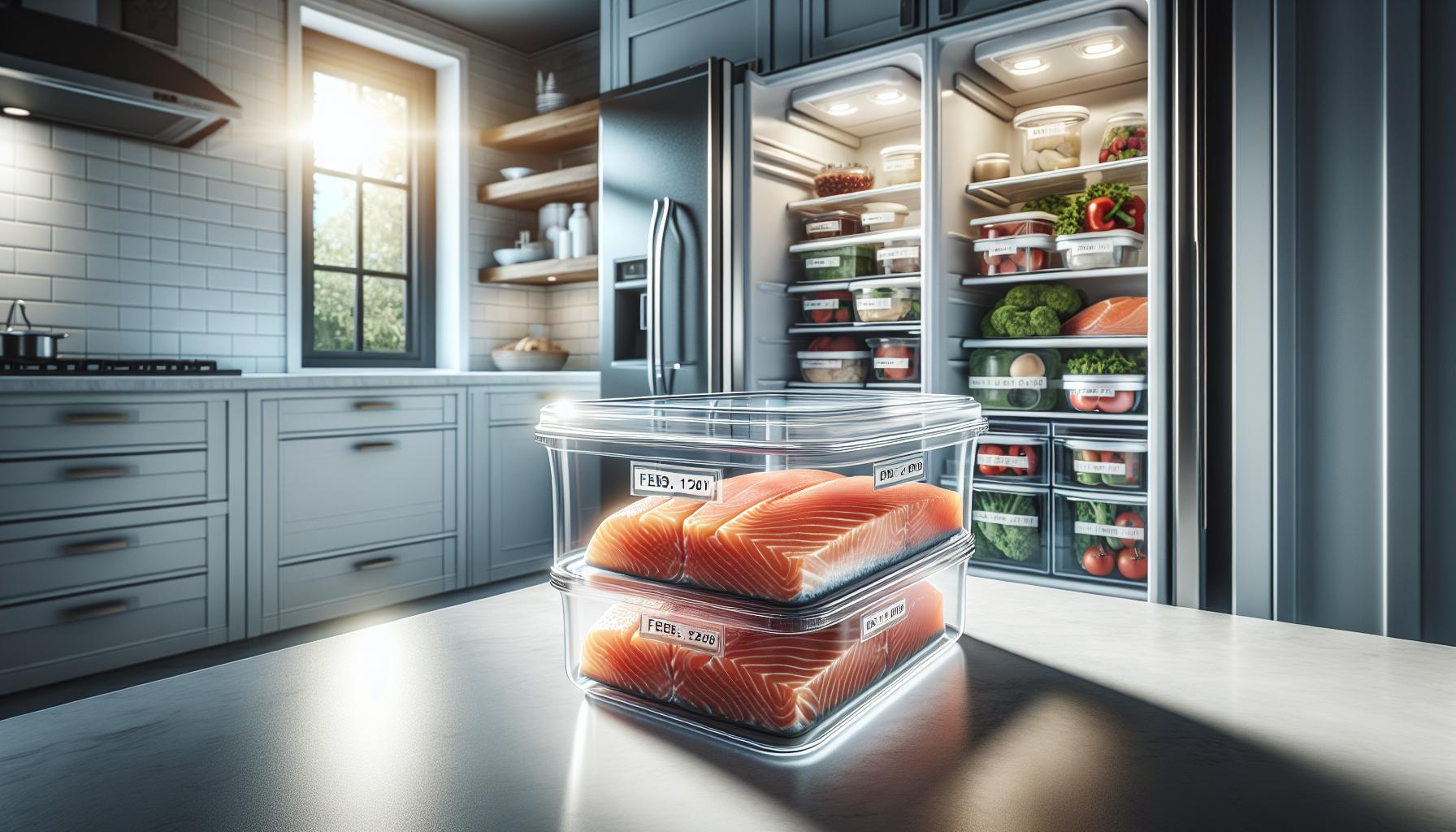Did you know that cooked shrimp can remain safe to eat for only a limited time in your refrigerator? For seafood lovers, understanding proper storage guidelines is essential to ensure freshness and minimize waste. This article will guide you through how long cooked shrimp lasts in the fridge, allowing you to enjoy your favorite seafood dishes without worry.
Whether you’re a meal prep enthusiast or simply love leftovers, knowing the lifespan of cooked shrimp can help you make informed decisions about your meals and reduce the risk of foodborne illness. Join us as we uncover the best practices for storing cooked shrimp, including tips and safety measures, ensuring you can enjoy delicious, safe seafood for days to come. Don’t let your culinary creations go to waste-read on to discover how to maximize their shelf life!
How Long Can Cooked Shrimp Stay Fresh?
Properly stored cooked shrimp can be a delightful addition to your meals, but understanding how long they remain safe and fresh is crucial for both enjoying their flavor and adhering to food safety standards. In general, cooked shrimp can stay fresh in the refrigerator for up to three to four days when stored correctly. After this time, the risk of spoilage increases, and the shrimp may lose their quality, flavor, and safety for consumption.
To ensure your shrimp retains its freshness as long as possible, it’s important to consider several factors. When refrigerating, always place the shrimp in an airtight container or tightly wrap it in aluminum foil or plastic wrap to prevent exposure to air and moisture, which can accelerate spoilage. Additionally, keeping your refrigerator at or below 40°F (4°C) is key to maintaining food safety and freshness.
For extended storage, cooked shrimp can be frozen, where they will remain safe to eat for about two to three months. However, freezing shrimp may alter their texture and reduce their quality over time. To freeze properly, make sure to remove as much air as possible from the storage bag or container. With these guidelines, you can confidently enjoy your cooked shrimp while minimizing waste and maximizing flavor.
Safe Storage Practices for Cooked Shrimp
Keeping cooked shrimp fresh is essential not only for preserving its delightful taste but also for ensuring food safety. Proper storage practices can significantly extend the shelf life of your seafood. When it comes to refrigerating cooked shrimp, always opt for an airtight container. This simple step prevents air exposure, which can lead to rapid spoilage. If an airtight container isn’t accessible, tightly wrapping the shrimp in aluminum foil or plastic wrap is a suitable alternative. Maintaining your refrigerator at or below 40°F (4°C) is also crucial, as this temperature inhibits bacterial growth and keeps your shrimp safe for consumption.
For longer-term storage, freezing cooked shrimp can be an effective method. When freezing, utilize resealable plastic bags or freezer-safe containers designed to minimize air contact. The key is to remove as much air as possible before sealing, which helps in preserving the shrimp’s texture and flavor. While properly frozen cooked shrimp can last between two to three months, it’s essential to note that the quality might diminish over time, similar to most frozen seafood. Be sure to label containers with storage dates to stay organized and avoid leaving shrimp too long in the freezer.
In addition to ensuring the quality of your shrimp, understanding safe handling practices during storage can help mitigate foodborne illness risks. Always refrigerate cooked shrimp within two hours of cooking to prevent the growth of harmful bacteria. When reheating shrimp, it’s advisable to heat it to an internal temperature of 165°F (74°C) to ensure it is safe to eat again. Following these storage guidelines not only preserves flavor and texture but also prioritizes your health and safety, allowing you to enjoy delicious shrimp dishes confidently.
Signs Cooked Shrimp Has Spoiled
Cooked shrimp can be a delightful addition to many meals, but keeping a keen eye on its freshness is crucial to ensure both flavor and safety. When shrimp spoil, it can pose health risks that are best avoided through careful observation. One of the most immediate signs that cooked shrimp has gone bad is its smell. Fresh shrimp typically have a mild ocean fragrance; however, if you detect a strong, fishy, or sour odor, it’s a clear indicator that the shrimp is no longer safe to eat.
Another telling sign is the appearance of the shrimp. Freshly cooked shrimp should be a bright pink or reddish color, while spoiled shrimp may appear dull, greyish, or develop white spots. Additionally, pay attention to the texture; if the shrimp feels excessively slimy or sticky, these are strong indications that bacteria have taken hold, and consumption is unsafe. Always be aware of the time frame since cooking; if shrimp has been stored in the refrigerator for more than three to four days, it’s prudent to discard it, regardless of other signs.
Storage Duration
The shelf life of cooked shrimp can vary, but when in doubt, refer to these general guidelines:
| Condition | Freshness Duration |
|---|---|
| Refrigerated (40°F/4°C or below) | 3-4 days |
| Frozen | 2-3 months |
To maximize safety, always store cooked shrimp in an airtight container, ensuring a secure seal to keep contaminants at bay. Being vigilant about these signs not only aids in maintaining your health but also enhances your enjoyment of shrimp dishes, allowing you to savor their flavorful benefits without worry.
Best Containers for Shrimp Storage
When it comes to ensuring the longevity and quality of your cooked shrimp, selecting the right storage containers is pivotal. The choice of container not only affects freshness but also minimizes the risk of contamination. For optimal results, consider using the following types of storage solutions:
- Airtight Containers: Glass or plastic containers with a tight seal are ideal for storing cooked shrimp in the fridge. They prevent air exposure, which can cause spoilage, and you can easily see the contents, helping you keep track of freshness.
- Vacuum Seal Bags: Vacuum sealing cooked shrimp removes air from the packaging and prolongs freshness significantly. This method also reduces the likelihood of freezer burn if you plan on freezing the shrimp for later use.
- Freezer-Safe Zip-Top Bags: When freezing shrimp, use heavy-duty zip-top bags designed to withstand low temperatures. Squeeze out excess air before sealing to further protect the shrimp’s texture and flavor during freezing.
- Aluminum Foil or Wrap: For short-term storage, wrapping cooked shrimp tightly in aluminum foil or plastic wrap can be effective. However, make sure to use it in conjunction with other containers to enhance the seal.
Proper storage techniques are essential not only for flavor retention but also for food safety. Ensure that your containers are clean and, if possible, sterilized before use. Label your storage with the date of cooking to keep track of how long the shrimp has been stored. This simple step can help prevent keeping shrimp longer than the recommended 3-4 days in the refrigerator.
Remember, the temperature at which you store your shrimp is crucial. Keep your refrigerator at or below 40°F (4°C) to ensure the safest environment for stored seafood. By consistently using the right containers and practices, you can enjoy your delicious shrimp dishes while maximizing their shelf life and preserving their quality.
Refrigeration vs. Freezing: What’s Best?
When it comes to preserving the freshness of cooked shrimp, understanding the differences between refrigeration and freezing is crucial. Each method offers its advantages, and knowing when to use each can help ensure that your seafood maintains its quality while minimizing the risk of spoilage. For instance, cooked shrimp can last in the refrigerator for about 3 to 4 days if stored correctly. This is ideal for short-term use, especially if you plan to consume the shrimp soon after cooking. However, if you wish to extend their shelf life significantly-up to several months-freezing is your best option.
Refrigeration keeps cooked shrimp ready for easy access, perfect for meals throughout the week. However, improper storage can lead to bacteria growth, especially if the shrimp sits at temperatures above 40°F (4°C) for too long. Always store cooked shrimp in airtight containers or tightly wrapped to prevent exposure to air and moisture, which can accelerate spoilage. A quick sniff or visual check can indicate freshness, but if you notice any off odors or an unusual slimy texture, it’s best to discard the shrimp.
On the other hand, freezing cooked shrimp stops bacterial growth altogether, making it a safer and longer-lasting option. It’s important to note that for optimal quality, cooked shrimp should be frozen as soon as possible after cooking. Use freezer-safe containers or vacuum-seal bags to minimize air exposure, ensuring the shrimp retains its taste and texture when thawed. While frozen shrimp can last for up to 6 months, they are best used within 3 months for optimal quality. When you’re ready to enjoy them again, thaw shrimp safely in the refrigerator or under cold running water-never at room temperature, as this can lead to a food safety hazard.
In summary, if you plan to use your cooked shrimp in a few days, refrigeration is sufficient. For any longer storage, freezing is the ideal choice to keep your shrimp safe and delicious. Always prioritize food safety practices to enjoy your seafood dishes worry-free.
How to Reheat Cooked Shrimp Safely
Reheating cooked shrimp properly is essential to ensure that it remains safe to eat and retains its delicious flavor and texture. Though shrimp is a quick and easy protein to prepare, the process of reheating can sometimes lead to rubbery or overcooked results if not done carefully. The key lies in using gentle techniques that take into account the shrimp’s inherent delicacy and their previous cooking.
To reheat shrimp safely, consider the following methods:
Stovetop Method
Using the stovetop is one of the most efficient ways to reheat shrimp while preserving its moisture and texture. Follow these simple steps:
- Heat a skillet over medium heat and add a tablespoon of oil or butter.
- Once the oil is warm, add the cooked shrimp to the pan.
- Cook for 2 to 3 minutes, stirring frequently, until the shrimp are heated through. Avoid cooking them for too long to prevent toughness.
- If desired, add a splash of broth or water to create steam, which can help in rejuvenating the shrimp without drying it out.
Microwave Method
While microwaving is the quickest method, it requires careful attention to avoid overcooking. Here’s how to do it safely:
- Place the cooked shrimp in a microwave-safe dish and cover it with a microwave-safe lid or a damp paper towel. This step helps retain moisture.
- Heat on medium power for 30-second intervals, checking between each interval to see if they are warmed adequately. This may take 1 to 2 minutes total, depending on the amount of shrimp.
- Be aware that shrimp can continue to cook slightly after being removed, so stop heating when they are just hot.
Oven Method
Another effective way to reheat shrimp is in the oven, especially if you’re reheating a larger batch:
- Preheat your oven to 300°F (150°C). Place the shrimp in a single layer on a baking sheet.
- Cover the shrimp with aluminum foil to prevent them from drying out.
- Heat in the oven for about 10-15 minutes, or until the shrimp are warmed through.
When reheating shrimp, it’s important to remember that they should only be heated once after the initial cooking process. Repeatedly reheating can lead to moisture loss and a decline in texture. Additionally, if the shrimp has been in the fridge for more than 3 to 4 days, it’s best to err on the side of caution and discard any leftovers to avoid foodborne illnesses.
By utilizing these gentle reheating methods, you can enjoy your shrimp dishes while maintaining their delectable flavor and safety, allowing you to savor the delightful seafood experience even longer.
Maximizing Flavor: Tips for Storing Shrimp
To ensure that cooked shrimp remains flavorful and appealing while stored, it’s essential to implement proper techniques that protect its delicate taste and texture. One key tip is to allow the shrimp to cool to room temperature before storing; this prevents condensation from forming inside the storage container, which can lead to mushiness and spoilage. Aim to refrigerate cooked shrimp within two hours of preparation to maintain its quality.
For storage, using airtight containers is a best practice. Not only do these containers keep the shrimp fresh, but they also mitigate the absorption of odors from other foods. Glass containers are excellent choices as they don’t retain flavors and are easy to clean. When sealing the shrimp, ensure it is tightly packed to minimize air exposure, which can cause drying and a deterioration in flavor.
It’s also advantageous to label your containers with the storage date. Cooked shrimp, when stored properly in the refrigerator, is best consumed within 3 to 4 days. If you won’t be eating the shrimp within that timeframe, consider freezing it. Frozen cooked shrimp can maintain its quality for up to 6 months. When freezing, it’s beneficial to portion out the shrimp, as this allows you to thaw only what you need and prevents multiple freeze-thaw cycles that can diminish flavor and texture.
Finally, consider adding a zip-lock-style bag when freezing. Removing as much air as possible before sealing enhances preservation. Store the bag flat in the freezer for compact storage and quicker thawing. By following these guidelines, you can enjoy your shrimp at its best, ensuring maximum flavor in every bite even days after cooking.
Cooking Shrimp: Best Practices for Longevity
To ensure that your cooked shrimp retains its delectable flavor and texture over time, employing effective cooking practices is essential. The foundation for longevity begins with choosing the right shrimp. Select high-quality, fresh shrimp that are properly cleaned and deveined. The preparation method matters too; steaming, boiling, or sautéing shrimp quickly is preferable as overcooking can lead to rubbery texture and diminished taste.
Once your shrimp is cooked, the immediate handling plays a crucial role in maintaining quality. Allow the shrimp to cool at room temperature for no more than two hours before moving it to storage. Rapid cooling is vital, as it minimizes the risk of bacterial growth. Prioritize refrigerating the shrimp within this time frame to preserve not just its safety but also its taste profile for future enjoyment.
Best Cooking Practices
For best practices in cooking shrimp that prolongs its freshness:
- Seasoning: Lightly seasoning before cooking helps enhance flavor, but avoid heavy sauces or marinades until serving to keep the shrimp’s taste intact during storage.
- Cooking Time: Keep cooking times short; shrimp typically requires only 2-3 minutes to cook through. Remove them from heat when they turn pink and opaque.
- Cooling Method: Spread the cooked shrimp on a baking sheet to cool quickly, which helps prevent sogginess from trapped steam.
By following these cooking practices, you set the stage for enjoying perfectly tender and flavorful shrimp, whether consumed immediately or stored for later. Correct techniques not only safeguard your shrimp’s taste but also ensure it remains safe and nutritious when stored properly in the refrigerator or freezer.
Common Mistakes in Shrimp Storage
Storing cooked shrimp correctly is vital for maintaining its flavor, texture, and most importantly, food safety. One of the most common mistakes is failing to cool shrimp quickly. Leaving cooked shrimp out at room temperature for extended periods can lead to bacterial growth, increasing the risk of foodborne illness. Ideally, shrimp should be refrigerated within two hours of cooking, or within one hour if the ambient temperature is above 90°F (32°C).
Another frequent oversight is using inadequate storage containers. Many people opt for shallow dishes, thinking that this will suffice, but it can lead to quick spoilage. Instead, using airtight containers or resealable plastic bags is far more effective. This practice minimizes exposure to air, preventing freezer burn when freezing and prolonging freshness in the fridge. Additionally, labeling containers with a date is beneficial for tracking how long the shrimp has been stored, offering a straightforward way to avoid consuming spoiled food.
Improperly reheating cooked shrimp is another common error. While it may seem convenient to throw shrimp straight into the microwave, this method can result in uneven heating-leading to dryness in some areas and potential food safety hazards in others. A better approach is to reheat shrimp gently on the stovetop or in the oven, using low heat to restore moisture while ensuring that the internal temperature reaches at least 165°F (74°C) to kill any harmful bacteria that may have developed during storage.
Moreover, many may believe that because shrimp is seafood, it can be stored longer than non-seafood items. In reality, cooked shrimp should typically be consumed within 3-4 days when stored properly in the refrigerator. By following these simple guidelines, you not only maximize the shelf life of your shrimp but also ensure that every bite is deliciously safe.
How to Tell if Shrimp Is Fresh Before Cooking
Determining the freshness of shrimp before cooking is crucial for both flavor and food safety. Fresh shrimp should have a clean, briny smell reminiscent of the ocean. If you detect a strong, unpleasant odor, it’s a significant indicator that the shrimp has spoiled. Visual cues are also essential; fresh shrimp should have a translucent, slightly glossy appearance. Look for shells that are intact and show no discoloration. Any black spots on the shell or meat suggest that the shrimp is past its prime and should be discarded.
Another quick method to assess shrimp freshness is by examining its texture. Fresh shrimp should feel firm to the touch, with a slight bounce. If the shrimp is slimy or mushy, it’s likely gone bad. You can also check for clarity in the flesh; it should be a bright white or off-white color. If there are variations like gray or brown hues, that’s a warning sign that the shrimp is not fresh.
Understanding labels is equally important when purchasing shrimp. Always opt for shrimp that has been stored on ice or kept cold in a refrigerated case. If buying frozen shrimp, ensure it’s packed properly without frost or icy buildup. This can indicate that the shrimp has thawed and been refrozen, which could compromise its quality and safety. By being vigilant about these signs, you can confidently choose shrimp that is not only fresh but also safe to eat, ultimately enhancing your seafood dining experience.
Nutritional Benefits of Properly Stored Shrimp
Proper storage of cooked shrimp is essential not just for safety but also for preserving its nutritional benefits. When shrimp is cooked and stored correctly, it remains a highly nutritious protein source rich in essential nutrients. Regardless of how you choose to prepare it, understanding how to store shrimp effectively can help you enjoy its health benefits longer.
Cooked shrimp is low in calories yet high in protein, making it an excellent choice for those seeking a healthy diet. A 3-ounce serving of cooked shrimp typically contains around 20 grams of protein, providing a substantial amount for muscle maintenance and repair. Additionally, shrimp is a rich source of omega-3 fatty acids, which are crucial for heart health. These healthy fats can help reduce inflammation, lower blood pressure, and contribute to overall cardiovascular wellness.
To maximize the nutritional benefits, it’s important to adhere to safe storage practices. Cooked shrimp should ideally be consumed within 3-4 days when stored in the refrigerator. If you need to store shrimp for longer, freezing is an excellent option, extending its usability for up to 6 months without significant loss of quality. When frozen properly, shrimp can retain its flavors and nutrients, making it a convenient option for quick meals.
Furthermore, proper rewarming techniques are crucial to maintaining both safety and nutrition. Avoid reheating shrimp multiple times, as it can lead to food safety issues and the potential degradation of its nutrients. Instead, aim for a single reheating process, using methods that retain moisture, such as steaming or sautéing. A well-managed approach to storing and reheating shrimp not only ensures food safety but also guarantees that you enjoy all the beneficial aspects of this versatile seafood.
Q&A
Q: How long can I keep cooked shrimp in the fridge?
A: Cooked shrimp can be safely stored in the refrigerator for 3 to 4 days. Ensure they are kept in an airtight container to maintain freshness and prevent contamination.
Q: Can you eat cooked shrimp after 5 days in the fridge?
A: It is not recommended to eat cooked shrimp after 5 days in the fridge. Consuming shrimp beyond the 4-day period increases the risk of foodborne illness.
Q: How can I tell if cooked shrimp is bad?
A: Signs that cooked shrimp has spoiled include a sour smell, a slimy texture, or discoloration. If you notice any of these indicators, it’s best to discard the shrimp.
Q: Can I freeze cooked shrimp to prolong its shelf life?
A: Yes, cooked shrimp can be frozen to extend its shelf life. Place them in a freezer-safe bag or container, and they will last for about 6 months in the freezer. For best quality, consume them within this timeframe.
Q: What’s the safest way to reheat cooked shrimp?
A: The safest way to reheat cooked shrimp is to do so gently on the stove or in the microwave until they reach an internal temperature of 165°F. Avoid overheating to prevent a rubbery texture.
Q: Can I leave cooked shrimp out overnight?
A: No, cooked shrimp should not be left out at room temperature for more than 2 hours. After this time, bacteria can multiply rapidly, making it unsafe to eat.
Q: Is it better to store cooked shrimp in water or dry?
A: It’s better to store cooked shrimp dry in an airtight container. Adding water might lead to spoilage faster. If using container storage, ensure they are kept well-covered to prevent drying out.
Q: How should I store leftover shrimp to maintain flavor?
A: To maintain flavor, store leftover shrimp in an airtight container in the fridge. Consider adding a squeeze of lemon juice or herbs for extra freshness. For long-term storage, freezing is the best option.
The Way Forward
Now that you know how long cooked shrimp can safely last in the fridge, you can enjoy your seafood dishes with confidence. Remember, for optimal freshness and quality, it’s best to consume your leftovers within three to four days. If you have any concerns about food safety, don’t hesitate to check out our detailed guide on seafood storage (insert link here) and explore our tips for extending the shelf life of other seafood options (insert link here).
Ready to elevate your culinary skills? Sign up for our newsletter to receive delicious seafood recipes and handy kitchen tips straight to your inbox! If you have questions or insights, share them in the comments below-we love hearing from our readers! For more great food safety information, visit our related articles that cover safe cooking temperatures and best practices for freezing seafood. Happy cooking!





